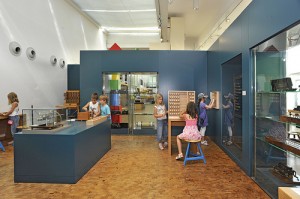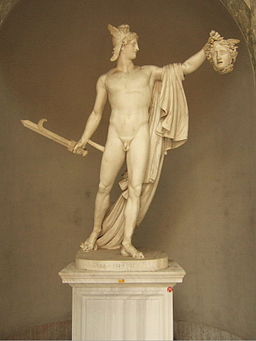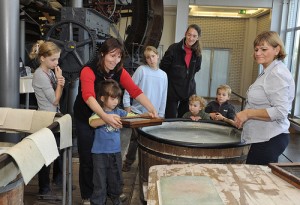by Alana Cole-Faber
A few weeks ago, I took my four-year-old twins to the Metropolitan Museum of Art in New York to see the museum’s beautiful Neapolitan crèche. Of course, once we arrived we were easily distracted by mummies and temples and sculpture and barely made time for the crèche itself. While strolling through one of the European sculpture halls, my children became enthralled by Antonio Canova’s Perseus with the Head of Medusa. We had read the story of Perseus several times in the past, and this depiction of the hero was immediately recognizable to them. My daughter was pleased to see that Perseus was wearing a helmet, but my son was rather upset that he seemed to have forgotten a crucial gift from Athena: a reflective shield. While the twins were debating the accuracy of the sculpture, two men walked by. One said to the other, “Oh, hey, it’s a sculpture of that guy from that myth.” My daughter overheard and softly replied, “Perseus,” but the men did not hear her. The second man said, “Yeah, it’s that guy who killed Medusa. What was his name?” The men stood silently scratching their heads for a few moments. “Perseus,” my daughter said a little louder, but again she was ignored. “Perseus!” exclaimed the first man after a long pause, at which point my daughter turned to me and said, “I told him it was Perseus, but he didn’t listen to me.”“He didn’t listen to me.” I could hear my daughter’s words in my head as I read the recent article about children in museums by Tiffany Jenkins entitled, “Children Should Be Seen and Not Heard.” The author asserts that museums have become too child-friendly in recent years and claims this is essentially a waste of funds, since she believes children are incapable of truly benefitting from the collections that museums offer. The article so severely critiques the inclusion of children in museums that it almost reads as satire. Almost.

Children discovering the secret of calculating machines in the TECHNOSEUM in Mannheim/Germany. TECHNOSEUM, picture Klaus Luginsland
Ms. Jenkins’s assertion that museums have become too child-friendly is impossible to support. I have worked with and visited many museums in many different countries over the years. Not once have I ever believed that any museum was too child-centered. I recently visited the Smithsonian’s Air and Space Museum, which in the United States is a sort of museum mecca for little ones. Airplanes and rocket ships hang from the ceiling, and there are interactives and videos throughout the galleries. There are children everywhere, and plenty of things for them to touch and climb upon. If any museum might be accused of being overly geared towards children, this one might be it. Yet I noticed at each interactive, there were at least as many adults participating as children. Grandfathers pointed out famous aircraft to their small companions, and children asked repeatedly of their parents, “What does this say? What is that?” It was loud, sure, but there was learning taking place in every nook and cranny of those galleries by visitors of all ages. I have no doubt at least some of those children will be returning as adults, sharing their experience with their own children and grandchildren.
If our museums are not for children, then whom are they for? Are we not in this business to preserve art, culture, and history for future generations? For those of us who work behind-the-scenes with collections, it is easy to think of the work of enticing our youngest citizens into museums as something apart from us. At some point in our careers, most of us have said, “Oh, I’m not really a curator and/or educator.” But we who preserve the stuff are part of that educational mission, and it is in our best interest that it succeed. If we are not teaching our youngsters that what we do matters, that all of this old stuff we care for has value, then we are surely all out of a job when the next generation comes of age, and Ms. Jenkins will be without her “palace of knowledge” altogether. Next time we hear a noisy bunch of school children wandering through a museum gallery, perhaps we should be thankful someone cares enough to bring them. And then we can make sure they don’t touch anything they are not supposed to.If you were waiting for the outcome of the Registrar’s Trilemma, wait one more week, we will reveal it on January 17.

